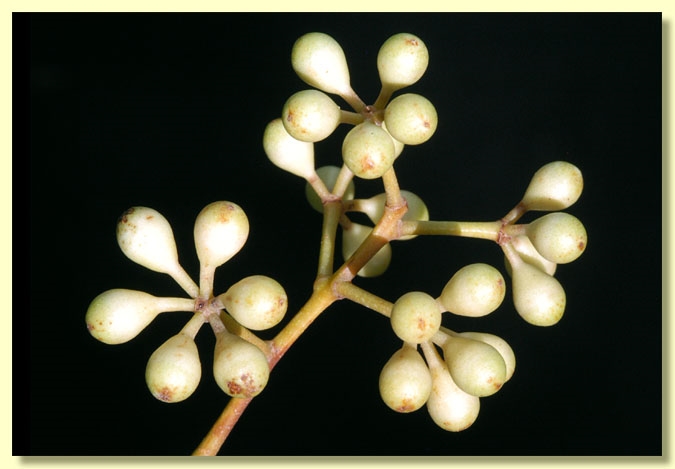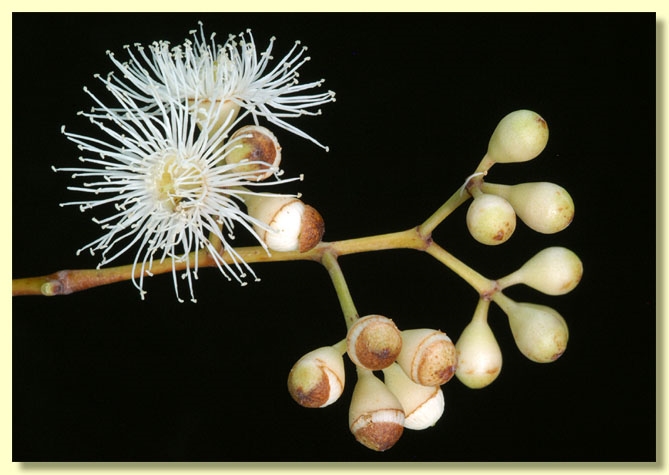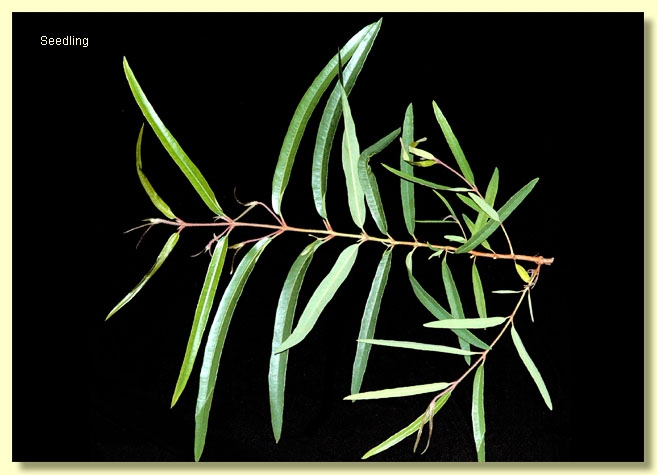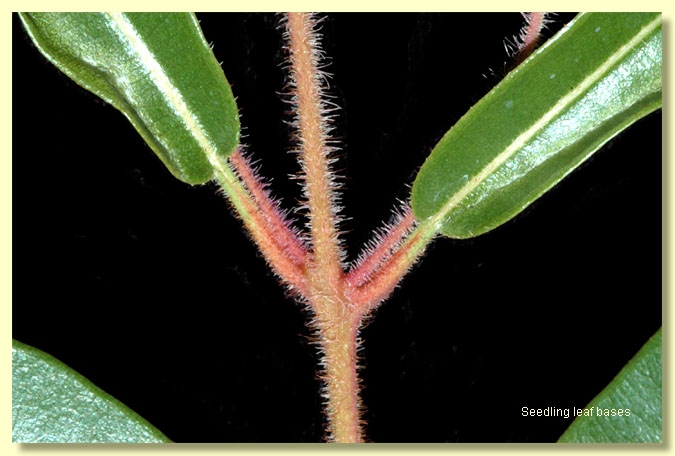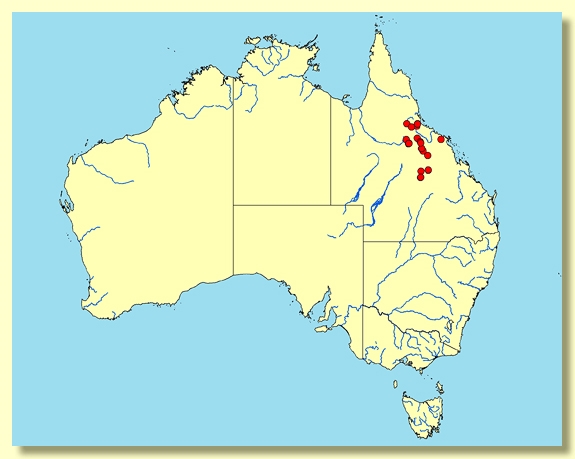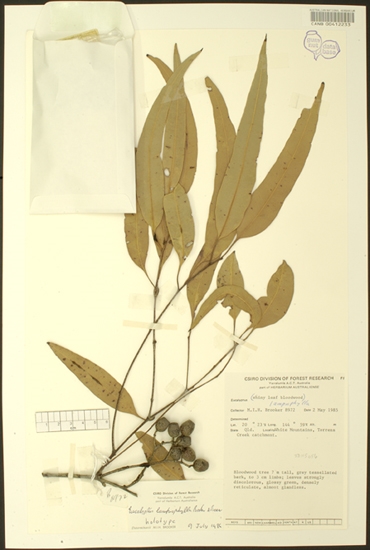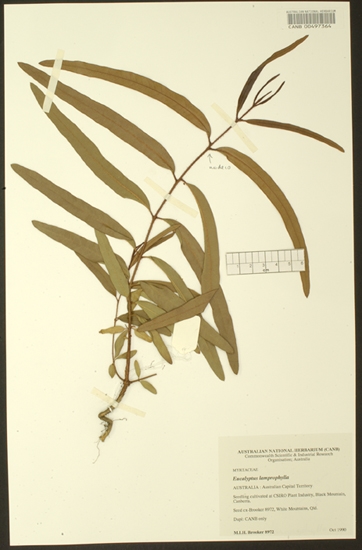Euclid - Online edition
Corymbia lamprophylla
Corymbia | Rufaria
Corymbia lamprophylla (Brooker & A.R.Bean) K.D.Hill & L.A.S.Johnson, Telopea 6: 287 (1995).
Tree to 15 m tall. Forming a lignotuber.
Bark rough over trunk and branches to ca 3 cm diameter, chunky, deeply tessellated, often friable, brown to grey-brown to yellow-brown over light pinkish brown.
Branchlets smooth (glabrous); elongated oil bodies sometimes visible in the pith.
Juvenile growth (coppice or field seedlings to 50 cm): stems rounded in cross-section, setose for ca 25 nodes; juvenile leaves always shortly petiolate, opposite or becoming alternate after ca 30 cm tall, lanceolate, 6.5–13.5 cm long, (0.5)1–2 cm wide, base tapering to petiole, apex pointed, glossy, green, discolorous, sparsely setose on underside or almost glabrous with setae on petiole only.
Adult leaves alternate, petioles 1–3 cm long; blade lanceolate, 7–18 cm long, 1–3 cm wide, base tapering to petiole, margin entire, apex finely pointed, discolorous, very glossy, smooth, side-veins greater than 45° to midrib, reticulation dense to very dense, intramarginal vein present, oil glands island, one per areole, or obscure.
Inflorescence terminal compound, peduncles 0.8–1.7 cm long, buds 7 per umbel, usually pedicellate (pedicels 0–0.3 cm long). Mature buds pyriform to obovoid to ovoid, 0.6–0.9 cm long, 0.4–0.6 cm wide, smooth, scar absent (both opercula shed together at flowering), operculum shallowly rounded sometimes umbonate, stamens inflexed, all fertile, anthers oblong, dorsifixed, versatile, dehiscing by longitudinal slits, style long and straight, stigma blunt but with a fringe of papillae visible, locules 4, the ovules not arranged in clear rows on the placentae, or arranged in 5 rows. Flowers creamy white.
Fruit pedicellate or sometimes sessile (pedicels 0–1.1 cm long), urn-shaped and usually lacking a pronounced neck, simply tapering to the orifice which may be small, 1.1–1.8(2.1) cm long, 1–1.4(1.7) cm wide, usually longer than wide, rim thick and fruit generally thick-walled, surface smooth and sometimes speckled, disc descending vertically, valves 4, enclosed.
Seeds brown, 5–8 mm long, ellipsoidal with terminal wing, hilum ventral.
Cultivated seedlings (measured at ca node 10): cotyledons reniform; stems rounded in cross-section, setose with long and short bristle-glands for at least 13 internodes; leaves shortly petiolate (to 1 cm), opposite, linear-oblong to narrowly lanceolate or narrowly falcate, 9–19.5 cm long, 0.8–2.5 cm wide, base lobed, rounded or tapering to petiole, never peltate, lower leaves dull, setose on both surfaces until ca node 8–9 then very glossy, green, and glabrous above, paler and setose on underside and margin until at least node 13.
Flowering has been recorded in January, March, April and August.
Bloodwood tree widespread in central-eastern Queensland from near Jericho in the south extending north through the Burra Range and White Mountains between Hughenden and Charters Towers, and further north to Greenvale, and east to the sub-coastal ranges of Hidden Valley west of Paluma, Mingela and inland from Bowen. It prefers shallow gravelly soil on sandstone and laterite ridges. Corymbia lamprophylla has brownish rough bark except for the outermost branches which are smooth, a crown of glossy dark green leaves that are paler on the underside, smooth buds in terminal inflorescences, pedicellate thick-walled fruit that, whilst ± urn-shaped, lack a clearly defined neck and are 1–1.4(1.7) cm wide. Seeds have a terminal wing and the juvenile leaves are narrow, glossy green with some hairs on the paler underside.
C. lamprophylla often grows with C. setosa, the only bloodwood in Queensland with opposite leaves making up the crown. C. setosa also has setose to scabrid buds.
Within its area of occurrence, C. lamprophylla grows with or near a range of other bloodwood species with rough bark and discolorous leaves. In the north of its distribution it may be confused with C. abergiana, which differs most noticeably in the buds, which are brown-scurfy, and the sessile fruit, which are wider than in C. lamprophylla. Also in the north C. ligans differs by the scurfy buds and more barrel-shaped fruit of similar size to those of C. lamprophylla; likewise C. clarksoniana also has scurfy buds, similar urn-shaped fruit about the same size as those of C. lamprophylla but has broader juvenile leaves; and C. serendipita, which has thin rough red-brown bark, smooth buds but smaller fruit, < 1cm wide compared with C. lamprophylla. In the absence of buds C. lamprophylla should still be distinguishable because of its extremely glossy adult and narrow glossy juvenile leaves.
Species with more southerly distribution in the general inland area where C. lamprophylla grows are: C. plena, which differs by the scurfy plump buds, slightly larger and thicker-walled fruit and dull adult leaves; C. hendersonii, which has smooth buds but differs in the usually wider and definitely thicker-walled stout fruit with larger orifice; C. brachycarpa, which has smooth buds and similar sized urn-shaped fruit usually with a pronounced neck and adult leaves never as glossy as those of C. lamprophylla; and C. clandestina, a very restricted species west of Clermont, which differs in the much smaller urn-shaped fruit. Another species, C. terminalis, has concolorous leaves (or almost so) and differs from C. lamprophylla in the scurfy buds and smaller, broader dull juvenile leaves.
The widespread brown bloodwood, C. trachyphloia, differs from C. lamprophylla in the smaller fruits (< 0.9 cm wide) and wingless seeds.
C. lamprophylla was described in 1987, and prior to that, specimens were considered to be an inland form of C. intermedia, a widespread species of wetter coastal mountains and plains. C. intermedia has broader seedling leaves, less glossy adult leaves, and longer pedicels than C. lamprophylla.
MORE ABOUT CORYMBIA
MORE ABOUT RED BLOODWOODS
Corymbia lamprophylla: Greek lampro, shining and phyllon leaf, referring to the glossy crown leaves.



